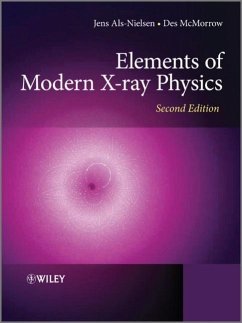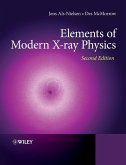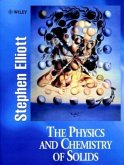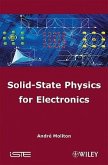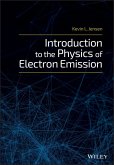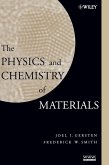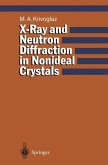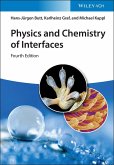- Gebundenes Buch
- Merkliste
- Auf die Merkliste
- Bewerten Bewerten
- Teilen
- Produkt teilen
- Produkterinnerung
- Produkterinnerung
Eagerly awaited, this second edition of a best-selling text comprehensively describes from a modern perspective the basics of x-ray physics as well as the completely new opportunities offered by synchrotron radiation. Written by internationally acclaimed authors, the style of the book is to develop the basic physical principles without obscuring them with excessive mathematics.
The second edition differs substantially from the first edition, with over 30% new material, including: A new chapter on non-crystalline diffraction - designed to appeal to the large community who study the structure…mehr
Andere Kunden interessierten sich auch für
![Elements of Modern X-Ray Physics Elements of Modern X-Ray Physics]() Jens Als-NielsenElements of Modern X-Ray Physics68,99 €
Jens Als-NielsenElements of Modern X-Ray Physics68,99 €![The Physics and Chemistry of Solids The Physics and Chemistry of Solids]() Stephen ElliottThe Physics and Chemistry of Solids104,99 €
Stephen ElliottThe Physics and Chemistry of Solids104,99 €![Solid-State Physics for Electronics Solid-State Physics for Electronics]() Andre MolitonSolid-State Physics for Electronics292,99 €
Andre MolitonSolid-State Physics for Electronics292,99 €![Introduction to the Physics of Electron Emission Introduction to the Physics of Electron Emission]() Kevin L. JensenIntroduction to the Physics of Electron Emission155,99 €
Kevin L. JensenIntroduction to the Physics of Electron Emission155,99 €![The Physics and Chemistry of Materials The Physics and Chemistry of Materials]() Joel I. GerstenThe Physics and Chemistry of Materials212,99 €
Joel I. GerstenThe Physics and Chemistry of Materials212,99 €![X-Ray and Neutron Diffraction in Nonideal Crystals X-Ray and Neutron Diffraction in Nonideal Crystals]() Mikhail A. KrivoglazX-Ray and Neutron Diffraction in Nonideal Crystals100,99 €
Mikhail A. KrivoglazX-Ray and Neutron Diffraction in Nonideal Crystals100,99 €![Physics and Chemistry of Interfaces Physics and Chemistry of Interfaces]() Hans-Jürgen ButtPhysics and Chemistry of Interfaces52,99 €
Hans-Jürgen ButtPhysics and Chemistry of Interfaces52,99 €-
-
-
Eagerly awaited, this second edition of a best-selling text comprehensively describes from a modern perspective the basics of x-ray physics as well as the completely new opportunities offered by synchrotron radiation. Written by internationally acclaimed authors, the style of the book is to develop the basic physical principles without obscuring them with excessive mathematics.
The second edition differs substantially from the first edition, with over 30% new material, including:
A new chapter on non-crystalline diffraction - designed to appeal to the large community who study the structure of liquids, glasses, and most importantly polymers and bio-molecules
A new chapter on x-ray imaging - developed in close cooperation with many of the leading experts in the field
Two new chapters covering non-crystalline diffraction and imaging
Many important changes to various sections in the book have been made with a view to improving the exposition
Four-colour representation throughout the text to clarify key concepts
Extensive problems after each chapter
Praise for the previous edition:
"The publication of Jens Als-Nielsen and Des McMorrow's Elements of Modern X-ray Physics is a defining moment in the field of synchrotron radiation... a welcome addition to the bookshelves of synchrotron-radiation professionals and students alike.... The text is now my personal choice for teaching x-ray physics..." - Physics Today, 2002
Hinweis: Dieser Artikel kann nur an eine deutsche Lieferadresse ausgeliefert werden.
The second edition differs substantially from the first edition, with over 30% new material, including:
A new chapter on non-crystalline diffraction - designed to appeal to the large community who study the structure of liquids, glasses, and most importantly polymers and bio-molecules
A new chapter on x-ray imaging - developed in close cooperation with many of the leading experts in the field
Two new chapters covering non-crystalline diffraction and imaging
Many important changes to various sections in the book have been made with a view to improving the exposition
Four-colour representation throughout the text to clarify key concepts
Extensive problems after each chapter
Praise for the previous edition:
"The publication of Jens Als-Nielsen and Des McMorrow's Elements of Modern X-ray Physics is a defining moment in the field of synchrotron radiation... a welcome addition to the bookshelves of synchrotron-radiation professionals and students alike.... The text is now my personal choice for teaching x-ray physics..." - Physics Today, 2002
Hinweis: Dieser Artikel kann nur an eine deutsche Lieferadresse ausgeliefert werden.
Produktdetails
- Produktdetails
- Verlag: Wiley & Sons
- 2. Aufl.
- Seitenzahl: 434
- Erscheinungstermin: 4. April 2011
- Englisch
- Abmessung: 255mm x 197mm x 24mm
- Gewicht: 1090g
- ISBN-13: 9780470973950
- ISBN-10: 0470973951
- Artikelnr.: 33260021
- Herstellerkennzeichnung
- Libri GmbH
- Europaallee 1
- 36244 Bad Hersfeld
- 06621 890
- Verlag: Wiley & Sons
- 2. Aufl.
- Seitenzahl: 434
- Erscheinungstermin: 4. April 2011
- Englisch
- Abmessung: 255mm x 197mm x 24mm
- Gewicht: 1090g
- ISBN-13: 9780470973950
- ISBN-10: 0470973951
- Artikelnr.: 33260021
- Herstellerkennzeichnung
- Libri GmbH
- Europaallee 1
- 36244 Bad Hersfeld
- 06621 890
Professor Emeritus Jens Als-Nielsen of the Niels Bohr Institute, University of Copenhagen, has been a pioneer in the field of neutron and x-ray scattering contributing to setting high standards for large international synchrotron centres. Today Jens Als-Nielsen's research is still - even after his official retirement - concentrated around x-ray radiation's potential in biological and medical research.? He was educated as a civil engineer in the field of electrophysics and from 1961-1995 was employed at the Riso National Laboratory, as section leader for the Solid-State Physics Section and later as division leader for the Physics Division. He has spent time at the European Synchrotron Radiation Facility, ESRF, Grenoble. From 1995 until his retirement in 2007 he was professor in experimental solid-state physics at the Niels Bohr Institute, University of Copenhagen. In 1985 he received the European Physical Society's Hewlett-Packard prize in solid-state physics and in 2009 the Velux Fonden's Honour Award for his research in the field of neutron and X-ray scattering. Professor Desmond McMorrow is Professor of Physics at University College London. He received his B.Sc from Sheffield University in 1983and his PhD in 1987 from the University of Manchester. After spending time in research at Edinburgh and Oxford he then worked with at the Riso National Laboratory and collaborated with Professor Als-Nieslen between 1998 and 2003. In 2004 he took up his position at UCL and received from 2004 - 2009 the Royal Society Wolfson Merit Award. His research is focussed on understanding how electrons organise themselves in solids to produce the wonderfully diverse range of phenomena encountered in modern condensed matter physics. His research is based mainly on using x-rays and neutrons to probe the structural and magnetic correlations that dominate the low-energy behaviour of these and other interesting classes of solids.
Preface v
Preface to the first edition vi
Acknowledgements from the first edition vii
Notes on the use of this book vii
1 X-rays and their interaction with matter 1
1.1 X-rays: waves and photons 2
1.2 Scattering 5
1.3 Absorption 18
1.4 Refraction and reflection 23
1.5 Coherence 25
1.6 Magnetic interactions 27
1.7 Further reading 28
2 Sources 29
2.1 Early history and the X-ray tube 29
2.2 Introduction to synchrotron radiation 30
2.3 Synchrotron radiation from a circular arc 33
2.4 Undulator radiation 43
2.5 Wiggler radiation 59
2.6 Free-electron lasers 61
2.7 Compact light sources 62
2.8 Coherence volume and photon degeneracy 64
2.9 Further reading 66
2.10 Exercises 66
3 Refraction and reflection from interfaces 69
3.1 Refraction and phase shift in scattering 70
3.2 Refractive index and scattering length density 71
3.3 Refractive index including absorption 75
3.4 Snell's law and the Fresnel equations in the X-ray region 77
3.5 Reflection from a homogeneous slab 81
3.6 Specular reflection from multilayers 85
3.7 Reflectivity from a graded interface 89
3.8 Rough interfaces and surfaces 90
3.9 Examples of reflectivity studies 97
3.10 X-ray optics 101
3.11 Further reading 111
3.12 Exercises 111
4 Kinematical scattering I: non-crystalline materials 113
4.1 Two electrons 114
4.2 Scattering from an atom 118
4.3 Scattering from a molecule 123
4.4 Scattering from liquids and glasses 125
4.5 Small-angle X-ray scattering (SAXS) 134
4.6 Further reading 145
4.7 Exercises 145
5 Kinematical scattering II: crystalline order 147
5.1 Scattering from a crystal 147
5.2 Quasiperiodic structures 164
5.3 Crystal truncation rods 169
5.4 Lattice vibrations, the Debye-Waller factor and TDS 172
5.5 The measured intensity from a crystallite 179
5.6 Applications of kinematical diffraction 187
5.7 Further reading 203
5.8 Exercises 204
6 Diffraction by perfect crystals 207
6.1 One atomic layer: reflection and transmission 209
6.2 Kinematical reflection from a few layers 210
6.3 Darwin theory and dynamical diffraction 212
6.4 The Darwin reflectivity curve 216
6.5 DuMond diagrams 230
6.6 Further reading 237
6.7 Exercises 237
7 Photoelectric absorption 239
7.1 X-ray absorption by an isolated atom 242
7.2 EXAFS and near-edge structure 251
7.3 X-ray dichroism 261
7.4 ARPES 268
7.5 Further reading 271
7.6 Exercises 272
8 Resonant scattering 275
8.1 The forced charged oscillator model 277
8.2 The atom as an assembly of oscillators 281
8.3 The Kramers-Kronig relations 282
8.4 Numerical estimate of f ' 284
8.5 Breakdown of Friedel's law and Bijvoet pairs 289
8.6 The phase problem in crystallography 295
8.7 Quantum mechanical description 300
8.8 Further reading 302
8.9 Exercises 302
9 Imaging 305
9.1 Introduction 305
9.2 Absorption contrast imaging 307
9.3 Phase contrast imaging 318
9.4 Coherent diffraction imaging 329
9.5 Holography 337
9.6 Further reading 340
9.7 Exercises 340
A Scattering and absorption cross-sections 343
B Classical electric dipole radiation 349
C Quantization of the electromagnetic field 355
D Gaussian statistics 361
E Fourier transforms 363
F Comparison of X-rays with neutrons 371
G MATLABr computer programs 373
H Answers to exercises and hints 397
Bibliography 403
Index 407
List of symbols 417
Preface to the first edition vi
Acknowledgements from the first edition vii
Notes on the use of this book vii
1 X-rays and their interaction with matter 1
1.1 X-rays: waves and photons 2
1.2 Scattering 5
1.3 Absorption 18
1.4 Refraction and reflection 23
1.5 Coherence 25
1.6 Magnetic interactions 27
1.7 Further reading 28
2 Sources 29
2.1 Early history and the X-ray tube 29
2.2 Introduction to synchrotron radiation 30
2.3 Synchrotron radiation from a circular arc 33
2.4 Undulator radiation 43
2.5 Wiggler radiation 59
2.6 Free-electron lasers 61
2.7 Compact light sources 62
2.8 Coherence volume and photon degeneracy 64
2.9 Further reading 66
2.10 Exercises 66
3 Refraction and reflection from interfaces 69
3.1 Refraction and phase shift in scattering 70
3.2 Refractive index and scattering length density 71
3.3 Refractive index including absorption 75
3.4 Snell's law and the Fresnel equations in the X-ray region 77
3.5 Reflection from a homogeneous slab 81
3.6 Specular reflection from multilayers 85
3.7 Reflectivity from a graded interface 89
3.8 Rough interfaces and surfaces 90
3.9 Examples of reflectivity studies 97
3.10 X-ray optics 101
3.11 Further reading 111
3.12 Exercises 111
4 Kinematical scattering I: non-crystalline materials 113
4.1 Two electrons 114
4.2 Scattering from an atom 118
4.3 Scattering from a molecule 123
4.4 Scattering from liquids and glasses 125
4.5 Small-angle X-ray scattering (SAXS) 134
4.6 Further reading 145
4.7 Exercises 145
5 Kinematical scattering II: crystalline order 147
5.1 Scattering from a crystal 147
5.2 Quasiperiodic structures 164
5.3 Crystal truncation rods 169
5.4 Lattice vibrations, the Debye-Waller factor and TDS 172
5.5 The measured intensity from a crystallite 179
5.6 Applications of kinematical diffraction 187
5.7 Further reading 203
5.8 Exercises 204
6 Diffraction by perfect crystals 207
6.1 One atomic layer: reflection and transmission 209
6.2 Kinematical reflection from a few layers 210
6.3 Darwin theory and dynamical diffraction 212
6.4 The Darwin reflectivity curve 216
6.5 DuMond diagrams 230
6.6 Further reading 237
6.7 Exercises 237
7 Photoelectric absorption 239
7.1 X-ray absorption by an isolated atom 242
7.2 EXAFS and near-edge structure 251
7.3 X-ray dichroism 261
7.4 ARPES 268
7.5 Further reading 271
7.6 Exercises 272
8 Resonant scattering 275
8.1 The forced charged oscillator model 277
8.2 The atom as an assembly of oscillators 281
8.3 The Kramers-Kronig relations 282
8.4 Numerical estimate of f ' 284
8.5 Breakdown of Friedel's law and Bijvoet pairs 289
8.6 The phase problem in crystallography 295
8.7 Quantum mechanical description 300
8.8 Further reading 302
8.9 Exercises 302
9 Imaging 305
9.1 Introduction 305
9.2 Absorption contrast imaging 307
9.3 Phase contrast imaging 318
9.4 Coherent diffraction imaging 329
9.5 Holography 337
9.6 Further reading 340
9.7 Exercises 340
A Scattering and absorption cross-sections 343
B Classical electric dipole radiation 349
C Quantization of the electromagnetic field 355
D Gaussian statistics 361
E Fourier transforms 363
F Comparison of X-rays with neutrons 371
G MATLABr computer programs 373
H Answers to exercises and hints 397
Bibliography 403
Index 407
List of symbols 417
Preface v Preface to the
rst edition vi Acknowledgements from the
rst edition vii Notes on the use of this book vii 1 X-rays and their interaction with matter 1 1.1 X-rays: waves and photons 2 1.2 Scattering 5 1.3 Absorption 18 1.4 Refraction and re
ection 23 1.5 Coherence 25 1.6 Magnetic interactions 27 1.7 Further reading 28 2 Sources 29 2.1 Early history and the X-ray tube 29 2.2 Introduction to synchrotron radiation 30 2.3 Synchrotron radiation from a circular arc 33 2.4 Undulator radiation 43 2.5 Wiggler radiation 59 2.6 Free-electron lasers 61 2.7 Compact light sources 62 2.8 Coherence volume and photon degeneracy 64 2.9 Further reading 66 2.10 Exercises 66 3 Refraction and re
ection from interfaces 69 3.1 Refraction and phase shift in scattering 70 3.2 Refractive index and scattering length density 71 3.3 Refractive index including absorption 75 3.4 Snell's law and the Fresnel equations in the X-ray region 77 3.5 Re
ection from a homogeneous slab 81 3.6 Specular re
ection from multilayers 85 3.7 Re
ectivity from a graded interface 89 3.8 Rough interfaces and surfaces 90 3.9 Examples of re
ectivity studies 97 3.10 X-ray optics 101 3.11 Further reading 111 3.12 Exercises 111 4 Kinematical scattering I: non-crystalline materials 113 4.1 Two electrons 114 4.2 Scattering from an atom 118 4.3 Scattering from a molecule 123 4.4 Scattering from liquids and glasses 125 4.5 Small-angle X-ray scattering (SAXS) 134 4.6 Further reading 145 4.7 Exercises 145 5 Kinematical scattering II: crystalline order 147 5.1 Scattering from a crystal 147 5.2 Quasiperiodic structures 164 5.3 Crystal truncation rods 169 5.4 Lattice vibrations, the Debye-Waller factor and TDS 172 5.5 The measured intensity from a crystallite 179 5.6 Applications of kinematical diffraction 187 5.7 Further reading 203 5.8 Exercises 204 6 Diffraction by perfect crystals 207 6.1 One atomic layer: re
ection and transmission 209 6.2 Kinematical re
ection from a few layers 210 6.3 Darwin theory and dynamical diffraction 212 6.4 The Darwin re
ectivity curve 216 6.5 DuMond diagrams 230 6.6 Further reading 237 6.7 Exercises 7 Photoelectric absorption 239 7.1 X-ray absorption by an isolated atom 242 7.2 EXAFS and near-edge structure 251 7.3 X-ray dichroism 261 7.4 ARPES 268 7.5 Further reading 271 7.6 Exercises 272 8 Resonant scattering 275 8.1 The forced charged oscillator model 277 8.2 The atom as an assembly of oscillators 281 8.3 The Kramers-Kronig relations 282 8.4 Numerical estimate of f
284 8.5 Breakdown of Friedel's law and Bijvoet pairs 289 8.6 The phase problem in crystallography 295 8.7 Quantum mechanical description 300 8.8 Further reading 302 8.9 Exercises 302 9 Imaging 305 9.1 Introduction 305 9.2 Absorption contrast imaging 307 9.3 Phase contrast imaging 318 9.4 Coherent diffraction imaging 329 9.5 Holography 335 9.6 Further reading 340 9.7 Exercises 340 A Scattering and absorption cross-sections 343 B Classical electric dipole radiation 349 C Quantization of the electromagnetic
eld 355 D Gaussian statistics 361 E Fourier transforms 363 F Comparison of X-rays with neutrons 371 G MATLAB® computer programs 373 H Answers to exercises and hints 397 Bibliography 403 Index 407 List of symbols 417
rst edition vi Acknowledgements from the
rst edition vii Notes on the use of this book vii 1 X-rays and their interaction with matter 1 1.1 X-rays: waves and photons 2 1.2 Scattering 5 1.3 Absorption 18 1.4 Refraction and re
ection 23 1.5 Coherence 25 1.6 Magnetic interactions 27 1.7 Further reading 28 2 Sources 29 2.1 Early history and the X-ray tube 29 2.2 Introduction to synchrotron radiation 30 2.3 Synchrotron radiation from a circular arc 33 2.4 Undulator radiation 43 2.5 Wiggler radiation 59 2.6 Free-electron lasers 61 2.7 Compact light sources 62 2.8 Coherence volume and photon degeneracy 64 2.9 Further reading 66 2.10 Exercises 66 3 Refraction and re
ection from interfaces 69 3.1 Refraction and phase shift in scattering 70 3.2 Refractive index and scattering length density 71 3.3 Refractive index including absorption 75 3.4 Snell's law and the Fresnel equations in the X-ray region 77 3.5 Re
ection from a homogeneous slab 81 3.6 Specular re
ection from multilayers 85 3.7 Re
ectivity from a graded interface 89 3.8 Rough interfaces and surfaces 90 3.9 Examples of re
ectivity studies 97 3.10 X-ray optics 101 3.11 Further reading 111 3.12 Exercises 111 4 Kinematical scattering I: non-crystalline materials 113 4.1 Two electrons 114 4.2 Scattering from an atom 118 4.3 Scattering from a molecule 123 4.4 Scattering from liquids and glasses 125 4.5 Small-angle X-ray scattering (SAXS) 134 4.6 Further reading 145 4.7 Exercises 145 5 Kinematical scattering II: crystalline order 147 5.1 Scattering from a crystal 147 5.2 Quasiperiodic structures 164 5.3 Crystal truncation rods 169 5.4 Lattice vibrations, the Debye-Waller factor and TDS 172 5.5 The measured intensity from a crystallite 179 5.6 Applications of kinematical diffraction 187 5.7 Further reading 203 5.8 Exercises 204 6 Diffraction by perfect crystals 207 6.1 One atomic layer: re
ection and transmission 209 6.2 Kinematical re
ection from a few layers 210 6.3 Darwin theory and dynamical diffraction 212 6.4 The Darwin re
ectivity curve 216 6.5 DuMond diagrams 230 6.6 Further reading 237 6.7 Exercises 7 Photoelectric absorption 239 7.1 X-ray absorption by an isolated atom 242 7.2 EXAFS and near-edge structure 251 7.3 X-ray dichroism 261 7.4 ARPES 268 7.5 Further reading 271 7.6 Exercises 272 8 Resonant scattering 275 8.1 The forced charged oscillator model 277 8.2 The atom as an assembly of oscillators 281 8.3 The Kramers-Kronig relations 282 8.4 Numerical estimate of f
284 8.5 Breakdown of Friedel's law and Bijvoet pairs 289 8.6 The phase problem in crystallography 295 8.7 Quantum mechanical description 300 8.8 Further reading 302 8.9 Exercises 302 9 Imaging 305 9.1 Introduction 305 9.2 Absorption contrast imaging 307 9.3 Phase contrast imaging 318 9.4 Coherent diffraction imaging 329 9.5 Holography 335 9.6 Further reading 340 9.7 Exercises 340 A Scattering and absorption cross-sections 343 B Classical electric dipole radiation 349 C Quantization of the electromagnetic
eld 355 D Gaussian statistics 361 E Fourier transforms 363 F Comparison of X-rays with neutrons 371 G MATLAB® computer programs 373 H Answers to exercises and hints 397 Bibliography 403 Index 407 List of symbols 417
Preface v
Preface to the first edition vi
Acknowledgements from the first edition vii
Notes on the use of this book vii
1 X-rays and their interaction with matter 1
1.1 X-rays: waves and photons 2
1.2 Scattering 5
1.3 Absorption 18
1.4 Refraction and reflection 23
1.5 Coherence 25
1.6 Magnetic interactions 27
1.7 Further reading 28
2 Sources 29
2.1 Early history and the X-ray tube 29
2.2 Introduction to synchrotron radiation 30
2.3 Synchrotron radiation from a circular arc 33
2.4 Undulator radiation 43
2.5 Wiggler radiation 59
2.6 Free-electron lasers 61
2.7 Compact light sources 62
2.8 Coherence volume and photon degeneracy 64
2.9 Further reading 66
2.10 Exercises 66
3 Refraction and reflection from interfaces 69
3.1 Refraction and phase shift in scattering 70
3.2 Refractive index and scattering length density 71
3.3 Refractive index including absorption 75
3.4 Snell's law and the Fresnel equations in the X-ray region 77
3.5 Reflection from a homogeneous slab 81
3.6 Specular reflection from multilayers 85
3.7 Reflectivity from a graded interface 89
3.8 Rough interfaces and surfaces 90
3.9 Examples of reflectivity studies 97
3.10 X-ray optics 101
3.11 Further reading 111
3.12 Exercises 111
4 Kinematical scattering I: non-crystalline materials 113
4.1 Two electrons 114
4.2 Scattering from an atom 118
4.3 Scattering from a molecule 123
4.4 Scattering from liquids and glasses 125
4.5 Small-angle X-ray scattering (SAXS) 134
4.6 Further reading 145
4.7 Exercises 145
5 Kinematical scattering II: crystalline order 147
5.1 Scattering from a crystal 147
5.2 Quasiperiodic structures 164
5.3 Crystal truncation rods 169
5.4 Lattice vibrations, the Debye-Waller factor and TDS 172
5.5 The measured intensity from a crystallite 179
5.6 Applications of kinematical diffraction 187
5.7 Further reading 203
5.8 Exercises 204
6 Diffraction by perfect crystals 207
6.1 One atomic layer: reflection and transmission 209
6.2 Kinematical reflection from a few layers 210
6.3 Darwin theory and dynamical diffraction 212
6.4 The Darwin reflectivity curve 216
6.5 DuMond diagrams 230
6.6 Further reading 237
6.7 Exercises 237
7 Photoelectric absorption 239
7.1 X-ray absorption by an isolated atom 242
7.2 EXAFS and near-edge structure 251
7.3 X-ray dichroism 261
7.4 ARPES 268
7.5 Further reading 271
7.6 Exercises 272
8 Resonant scattering 275
8.1 The forced charged oscillator model 277
8.2 The atom as an assembly of oscillators 281
8.3 The Kramers-Kronig relations 282
8.4 Numerical estimate of f ' 284
8.5 Breakdown of Friedel's law and Bijvoet pairs 289
8.6 The phase problem in crystallography 295
8.7 Quantum mechanical description 300
8.8 Further reading 302
8.9 Exercises 302
9 Imaging 305
9.1 Introduction 305
9.2 Absorption contrast imaging 307
9.3 Phase contrast imaging 318
9.4 Coherent diffraction imaging 329
9.5 Holography 337
9.6 Further reading 340
9.7 Exercises 340
A Scattering and absorption cross-sections 343
B Classical electric dipole radiation 349
C Quantization of the electromagnetic field 355
D Gaussian statistics 361
E Fourier transforms 363
F Comparison of X-rays with neutrons 371
G MATLABr computer programs 373
H Answers to exercises and hints 397
Bibliography 403
Index 407
List of symbols 417
Preface to the first edition vi
Acknowledgements from the first edition vii
Notes on the use of this book vii
1 X-rays and their interaction with matter 1
1.1 X-rays: waves and photons 2
1.2 Scattering 5
1.3 Absorption 18
1.4 Refraction and reflection 23
1.5 Coherence 25
1.6 Magnetic interactions 27
1.7 Further reading 28
2 Sources 29
2.1 Early history and the X-ray tube 29
2.2 Introduction to synchrotron radiation 30
2.3 Synchrotron radiation from a circular arc 33
2.4 Undulator radiation 43
2.5 Wiggler radiation 59
2.6 Free-electron lasers 61
2.7 Compact light sources 62
2.8 Coherence volume and photon degeneracy 64
2.9 Further reading 66
2.10 Exercises 66
3 Refraction and reflection from interfaces 69
3.1 Refraction and phase shift in scattering 70
3.2 Refractive index and scattering length density 71
3.3 Refractive index including absorption 75
3.4 Snell's law and the Fresnel equations in the X-ray region 77
3.5 Reflection from a homogeneous slab 81
3.6 Specular reflection from multilayers 85
3.7 Reflectivity from a graded interface 89
3.8 Rough interfaces and surfaces 90
3.9 Examples of reflectivity studies 97
3.10 X-ray optics 101
3.11 Further reading 111
3.12 Exercises 111
4 Kinematical scattering I: non-crystalline materials 113
4.1 Two electrons 114
4.2 Scattering from an atom 118
4.3 Scattering from a molecule 123
4.4 Scattering from liquids and glasses 125
4.5 Small-angle X-ray scattering (SAXS) 134
4.6 Further reading 145
4.7 Exercises 145
5 Kinematical scattering II: crystalline order 147
5.1 Scattering from a crystal 147
5.2 Quasiperiodic structures 164
5.3 Crystal truncation rods 169
5.4 Lattice vibrations, the Debye-Waller factor and TDS 172
5.5 The measured intensity from a crystallite 179
5.6 Applications of kinematical diffraction 187
5.7 Further reading 203
5.8 Exercises 204
6 Diffraction by perfect crystals 207
6.1 One atomic layer: reflection and transmission 209
6.2 Kinematical reflection from a few layers 210
6.3 Darwin theory and dynamical diffraction 212
6.4 The Darwin reflectivity curve 216
6.5 DuMond diagrams 230
6.6 Further reading 237
6.7 Exercises 237
7 Photoelectric absorption 239
7.1 X-ray absorption by an isolated atom 242
7.2 EXAFS and near-edge structure 251
7.3 X-ray dichroism 261
7.4 ARPES 268
7.5 Further reading 271
7.6 Exercises 272
8 Resonant scattering 275
8.1 The forced charged oscillator model 277
8.2 The atom as an assembly of oscillators 281
8.3 The Kramers-Kronig relations 282
8.4 Numerical estimate of f ' 284
8.5 Breakdown of Friedel's law and Bijvoet pairs 289
8.6 The phase problem in crystallography 295
8.7 Quantum mechanical description 300
8.8 Further reading 302
8.9 Exercises 302
9 Imaging 305
9.1 Introduction 305
9.2 Absorption contrast imaging 307
9.3 Phase contrast imaging 318
9.4 Coherent diffraction imaging 329
9.5 Holography 337
9.6 Further reading 340
9.7 Exercises 340
A Scattering and absorption cross-sections 343
B Classical electric dipole radiation 349
C Quantization of the electromagnetic field 355
D Gaussian statistics 361
E Fourier transforms 363
F Comparison of X-rays with neutrons 371
G MATLABr computer programs 373
H Answers to exercises and hints 397
Bibliography 403
Index 407
List of symbols 417
Preface v Preface to the
rst edition vi Acknowledgements from the
rst edition vii Notes on the use of this book vii 1 X-rays and their interaction with matter 1 1.1 X-rays: waves and photons 2 1.2 Scattering 5 1.3 Absorption 18 1.4 Refraction and re
ection 23 1.5 Coherence 25 1.6 Magnetic interactions 27 1.7 Further reading 28 2 Sources 29 2.1 Early history and the X-ray tube 29 2.2 Introduction to synchrotron radiation 30 2.3 Synchrotron radiation from a circular arc 33 2.4 Undulator radiation 43 2.5 Wiggler radiation 59 2.6 Free-electron lasers 61 2.7 Compact light sources 62 2.8 Coherence volume and photon degeneracy 64 2.9 Further reading 66 2.10 Exercises 66 3 Refraction and re
ection from interfaces 69 3.1 Refraction and phase shift in scattering 70 3.2 Refractive index and scattering length density 71 3.3 Refractive index including absorption 75 3.4 Snell's law and the Fresnel equations in the X-ray region 77 3.5 Re
ection from a homogeneous slab 81 3.6 Specular re
ection from multilayers 85 3.7 Re
ectivity from a graded interface 89 3.8 Rough interfaces and surfaces 90 3.9 Examples of re
ectivity studies 97 3.10 X-ray optics 101 3.11 Further reading 111 3.12 Exercises 111 4 Kinematical scattering I: non-crystalline materials 113 4.1 Two electrons 114 4.2 Scattering from an atom 118 4.3 Scattering from a molecule 123 4.4 Scattering from liquids and glasses 125 4.5 Small-angle X-ray scattering (SAXS) 134 4.6 Further reading 145 4.7 Exercises 145 5 Kinematical scattering II: crystalline order 147 5.1 Scattering from a crystal 147 5.2 Quasiperiodic structures 164 5.3 Crystal truncation rods 169 5.4 Lattice vibrations, the Debye-Waller factor and TDS 172 5.5 The measured intensity from a crystallite 179 5.6 Applications of kinematical diffraction 187 5.7 Further reading 203 5.8 Exercises 204 6 Diffraction by perfect crystals 207 6.1 One atomic layer: re
ection and transmission 209 6.2 Kinematical re
ection from a few layers 210 6.3 Darwin theory and dynamical diffraction 212 6.4 The Darwin re
ectivity curve 216 6.5 DuMond diagrams 230 6.6 Further reading 237 6.7 Exercises 7 Photoelectric absorption 239 7.1 X-ray absorption by an isolated atom 242 7.2 EXAFS and near-edge structure 251 7.3 X-ray dichroism 261 7.4 ARPES 268 7.5 Further reading 271 7.6 Exercises 272 8 Resonant scattering 275 8.1 The forced charged oscillator model 277 8.2 The atom as an assembly of oscillators 281 8.3 The Kramers-Kronig relations 282 8.4 Numerical estimate of f
284 8.5 Breakdown of Friedel's law and Bijvoet pairs 289 8.6 The phase problem in crystallography 295 8.7 Quantum mechanical description 300 8.8 Further reading 302 8.9 Exercises 302 9 Imaging 305 9.1 Introduction 305 9.2 Absorption contrast imaging 307 9.3 Phase contrast imaging 318 9.4 Coherent diffraction imaging 329 9.5 Holography 335 9.6 Further reading 340 9.7 Exercises 340 A Scattering and absorption cross-sections 343 B Classical electric dipole radiation 349 C Quantization of the electromagnetic
eld 355 D Gaussian statistics 361 E Fourier transforms 363 F Comparison of X-rays with neutrons 371 G MATLAB® computer programs 373 H Answers to exercises and hints 397 Bibliography 403 Index 407 List of symbols 417
rst edition vi Acknowledgements from the
rst edition vii Notes on the use of this book vii 1 X-rays and their interaction with matter 1 1.1 X-rays: waves and photons 2 1.2 Scattering 5 1.3 Absorption 18 1.4 Refraction and re
ection 23 1.5 Coherence 25 1.6 Magnetic interactions 27 1.7 Further reading 28 2 Sources 29 2.1 Early history and the X-ray tube 29 2.2 Introduction to synchrotron radiation 30 2.3 Synchrotron radiation from a circular arc 33 2.4 Undulator radiation 43 2.5 Wiggler radiation 59 2.6 Free-electron lasers 61 2.7 Compact light sources 62 2.8 Coherence volume and photon degeneracy 64 2.9 Further reading 66 2.10 Exercises 66 3 Refraction and re
ection from interfaces 69 3.1 Refraction and phase shift in scattering 70 3.2 Refractive index and scattering length density 71 3.3 Refractive index including absorption 75 3.4 Snell's law and the Fresnel equations in the X-ray region 77 3.5 Re
ection from a homogeneous slab 81 3.6 Specular re
ection from multilayers 85 3.7 Re
ectivity from a graded interface 89 3.8 Rough interfaces and surfaces 90 3.9 Examples of re
ectivity studies 97 3.10 X-ray optics 101 3.11 Further reading 111 3.12 Exercises 111 4 Kinematical scattering I: non-crystalline materials 113 4.1 Two electrons 114 4.2 Scattering from an atom 118 4.3 Scattering from a molecule 123 4.4 Scattering from liquids and glasses 125 4.5 Small-angle X-ray scattering (SAXS) 134 4.6 Further reading 145 4.7 Exercises 145 5 Kinematical scattering II: crystalline order 147 5.1 Scattering from a crystal 147 5.2 Quasiperiodic structures 164 5.3 Crystal truncation rods 169 5.4 Lattice vibrations, the Debye-Waller factor and TDS 172 5.5 The measured intensity from a crystallite 179 5.6 Applications of kinematical diffraction 187 5.7 Further reading 203 5.8 Exercises 204 6 Diffraction by perfect crystals 207 6.1 One atomic layer: re
ection and transmission 209 6.2 Kinematical re
ection from a few layers 210 6.3 Darwin theory and dynamical diffraction 212 6.4 The Darwin re
ectivity curve 216 6.5 DuMond diagrams 230 6.6 Further reading 237 6.7 Exercises 7 Photoelectric absorption 239 7.1 X-ray absorption by an isolated atom 242 7.2 EXAFS and near-edge structure 251 7.3 X-ray dichroism 261 7.4 ARPES 268 7.5 Further reading 271 7.6 Exercises 272 8 Resonant scattering 275 8.1 The forced charged oscillator model 277 8.2 The atom as an assembly of oscillators 281 8.3 The Kramers-Kronig relations 282 8.4 Numerical estimate of f
284 8.5 Breakdown of Friedel's law and Bijvoet pairs 289 8.6 The phase problem in crystallography 295 8.7 Quantum mechanical description 300 8.8 Further reading 302 8.9 Exercises 302 9 Imaging 305 9.1 Introduction 305 9.2 Absorption contrast imaging 307 9.3 Phase contrast imaging 318 9.4 Coherent diffraction imaging 329 9.5 Holography 335 9.6 Further reading 340 9.7 Exercises 340 A Scattering and absorption cross-sections 343 B Classical electric dipole radiation 349 C Quantization of the electromagnetic
eld 355 D Gaussian statistics 361 E Fourier transforms 363 F Comparison of X-rays with neutrons 371 G MATLAB® computer programs 373 H Answers to exercises and hints 397 Bibliography 403 Index 407 List of symbols 417

